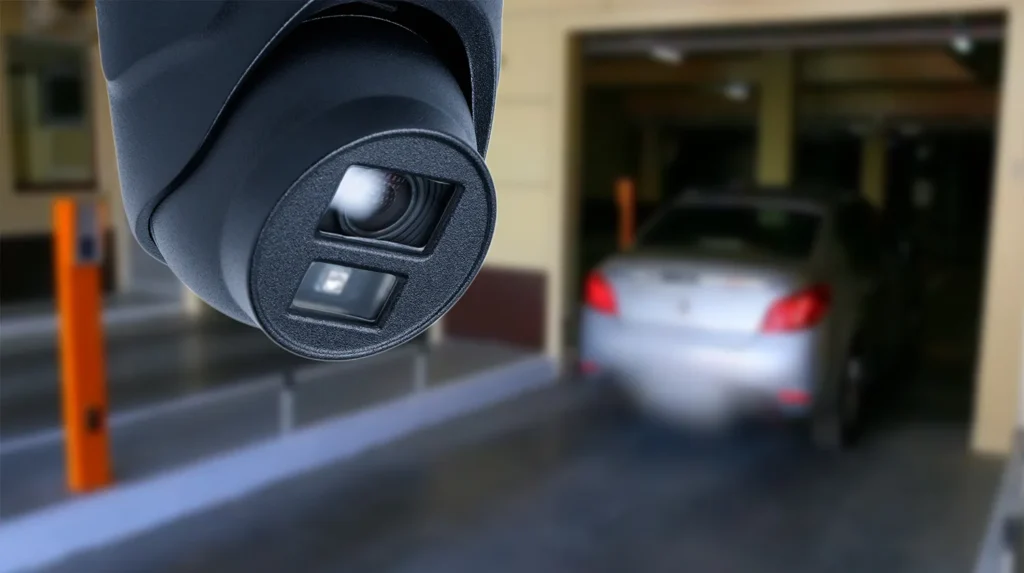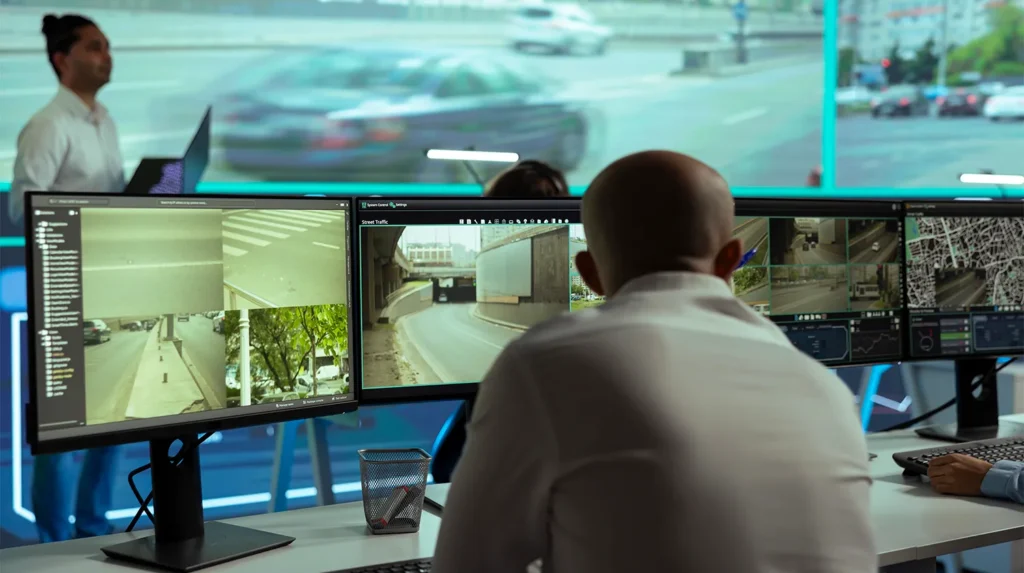A license plate reader (LPR) is a technology that captures and analyzes license plate information from vehicles. LPR systems, also known as automated license plate readers (ALPRs), use surveillance cameras to capture images of license plates, enabling law enforcement personnel and officers to collect data from vehicles in real time. It’s used by law enforcement to track stolen vehicles, identify suspects, and support criminal investigations. This guide will explain how LPR technology works, its uses, benefits, privacy concerns, and future trends.
Key Takeaways
- License Plate Reader technology, used mostly by U.S. police departments and law enforcement personnel, enhances public safety by identifying vehicles connected to criminal activity in real time.
- ALPRs use high-resolution cameras and optical character recognition to capture and analyze license plate information. This helps in criminal investigations and stolen vehicle recovery.
- Implementing ALPR technology raises privacy and ethical concerns, so transparency and standardized data retention policies are needed to protect individual privacy rights.
The Complete Guide to LPR Technology
LPR technology has come a long way since its inception in the 1970s. It was first used to enhance security measures in the UK at the Dartford Tunnel and A1 Road. Over the years, LPR technology has gotten less expensive and more user-friendly. It is now used by 93% of U.S. police departments in cities with more than one million people. Law enforcement personnel and officers utilize ALPRs to capture license plate information in real time, aiding in the efficient tracking and analysis of vehicle movements.
The evolution of automated license plate readers has expanded its applications beyond just law enforcement. ALPRs are now integral in various sectors, including traffic management, toll collection, and personal security.
The primary purpose of ALPRs is to identify and match license plates to those stored in databases of stolen cars or vehicles associated with criminal activity. In addition, LPR technology is used in traffic enforcement to monitor and manage traffic flow.
Whether used in policing, industry, personal security, or toll collection, ALPR systems are designed to be permanent installations at strategic locations. They can capture license plate images with high precision. These systems rely on lighting conditions and vehicle speeds and often have separate units for the camera and optical character recognition (OCR) software to improve accuracy.
An Introduction to ALPRs

ALPRs are a game-changer for law enforcement personnel and officers, designed to automatically capture and analyze license plate images and convert them into machine-readable LPR data using optical character recognition technology.
The benefits of LPR technology go beyond just tracking stolen vehicles. They also help with criminal investigations and suspect identification. With the ability to investigate hits quickly, law enforcement agencies can address crimes and locate missing persons more efficiently. This helps contribute to long-term public safety.
Understanding License Plate Readers
ALPRs have their origins in the 1970s. Today these systems use high-resolution digital cameras with infrared filters and optical character recognition to capture and analyze images of license plates in real time, aiding law enforcement personnel in their duties.
The real-time capabilities of ALPR systems make them even more efficient by allowing instantaneous license plate reading and analysis. However, capturing clear images of moving vehicles requires high precision. LPR cameras are designed to take multiple images in quick succession to create a clearer composite.
Lighting conditions and vehicle speeds can significantly affect the quality of the captured images, making the positioning and technology of the cameras crucial for effective operation.
Types of License Plate Readers
There are two types of automated license plate readers: stationary and mobile. Stationary ALPR cameras are fixed in one place, like traffic lights or toll booths. They are used to monitor traffic speed and capture vehicles as they pass by. These fixed installations are perfect for high-traffic areas because they provide continuous monitoring and data collection. Stationary ALPR cameras are also used in traffic management to monitor and control traffic flow at busy intersections.
Mobile ALPR cameras are mounted on vehicles, so law enforcement personnel can capture license plate data while on the move. These mobile units can be used in patrol cars or surveillance vans for more flexibility and broader coverage.
Multi-camera setups are among future advancements in LPR technology, enhancing accuracy and expanding the monitoring area.
How License Plate Readers Work

Automated license plate readers are sophisticated camera systems that automatically capture and record license plate information from passing vehicles, aiding law enforcement personnel in their duties. The system has a camera that captures images of license plates and a computer that uses OCR technology to turn those images into readable license plate numbers.
These camera systems can be mounted in fixed locations or on moving vehicles which makes them versatile for various applications. Integrating artificial intelligence and deep learning into LPR systems can enhance the ability to accurately identify license plates under challenging conditions, such as poor visibility.
Additionally, edge computing enables faster data processing by performing computations where data is collected. When a vehicle passes through an ALPR system, it captures the vehicle’s image, license plate characters, location, date, and time.
Data Collection and Storage
ALPRs can do more than just collect license plate numbers; they also capture the vehicle’s image, time, date, and location, enabling law enforcement personnel to track vehicle movements and create detailed records of their whereabouts.
In many jurisdictions, law enforcement agencies may keep license plate data indefinitely for future reference. This is usually accomplished through vendor contracts, which grant access to law enforcement agency databases containing license plate scans from various sources. However, agencies must follow proper data retention policies and ensure the relevant data is stored securely to protect individuals’ privacy rights.
Benefits for Law Enforcement Agencies

ALPRs are a powerful tool for law enforcement personnel and agencies. They help with crime investigations and vehicle recovery. As previously stated, approximately 93% of U.S. police departments in major cities use these systems to enhance their operations. Using ALPRs can increase stolen vehicle recovery rates by 50%. This offers a substantial advantage in tracking and recovering stolen vehicles.
ALPR systems can help quickly identify vehicles involved in crimes or linked to missing persons. This helps speed up investigations and interventions. The real-time alerting capabilities of ALPR systems direct law enforcement to crimes in progress and time-sensitive incidents. The result is enhanced response times and operational efficiency. Additionally, the ability to access historical location data can be instrumental in solving crimes and building cases.
Privacy and Ethical Concerns
The widespread use of ALPR technology raises some privacy and ethical concerns. Critics argue that these systems may facilitate unwarranted surveillance, which can infringe upon personal freedoms and create records of an individual’s whereabouts over time. Public support for ALPR systems varies based on the perceived trustworthiness of law enforcement agencies.
To address these concerns, police departments and law enforcement personnel must prioritize transparency by informing the public about how ALPR data is collected and used. Standardized data retention policies can mitigate privacy issues by ensuring that license plate data is only stored for as long as necessary to avoid unnecessary surveillance. Working with privacy advocates can enhance policies around ALPR use and address community concerns related to civil liberties.
Costs and Implementation

Implementing ALPR systems involves some substantial upfront costs, including expenses for hardware, software, and infrastructure. Operational costs may also include ongoing maintenance, software updates, and subscription fees.
Many agencies enter into vendor contracts to manage the costs and maintenance of ALPR systems, ensuring that law enforcement personnel have the necessary tools to perform their duties. Purchasing or subscribing to ALPR services is often dependent on budget constraints and specific agency needs. Despite these costs, the global LPR market is projected to grow significantly, reaching approximately 743 million USD by 2029.
Legal and Regulatory Landscape
The legal and regulatory landscape for automated license plate technology varies by jurisdiction. For example, California limits the retention of ALPR data to no more than 60 days unless it is to be used as evidence in a felony case. In Georgia, license plate data must be destroyed within 30 months unless it is related to a toll violation or ongoing law enforcement purpose.
Other states like New Hampshire and North Carolina have specific data retention policies on how long ALPR data can be retained and under what conditions, ensuring that law enforcement personnel use the data appropriately. These regulations are designed to protect personal information and limit access to ALPR data based on legitimate law enforcement purposes.
Best Practices for Using License Plate Readers
To ensure the ethical and effective use of automated license plate readers technology, law enforcement agencies should establish clear policies and train law enforcement personnel on the legal and ethical aspects of ALPR technology. These policies should include language about data retention policies and governing its use. Training law enforcement officers and personnel on the legal and ethical aspects of ALPR technology can help mitigate misuse and ensure compliance with privacy regulations.
Conducting regular audits and assessments of ALPR systems can help verify they are working properly and fairly. Efficient ALPR systems let law enforcement focus on public safety rather than on manual checks. This helps improve situational awareness and response times.
Real-World Applications of License Plate Readers

Automated license plate readers have many uses beyond just law enforcement. They are also used in traffic monitoring, parking management, and even toll collection. ALPR technology plays a key role in public safety by comparing captured license plate information against databases of stolen vehicles or those linked to criminal activity.
Law enforcement personnel use ALPRs to track vehicle movements over time, creating detailed historical records that can help in solving crimes. In addition, these systems can create detailed historical records that can help in solving crimes. Stationary cameras provide insights into traffic patterns and driver behaviors, which can result in more effective traffic management and planning.
Integrating live video monitoring with license plate recognition systems can create a powerful security solution that enhances real-time response capabilities. While LPR technology automatically captures and identifies license plates, live video monitoring adds an extra layer of protection – trained security professionals watching camera feeds in real time. This combination helps speed identification of flagged vehicles and promptly address any potential threats. By pairing LPR systems with live video monitoring, organizations can help improve their ability to detect, respond to, and deter security incidents.
Future Trends in ALPR Technology
The future of ALPR technology is encouraging, including advancements in optical character recognition for faster and more accurate license plate readings. The integration of AI and machine learning is improving data processing capabilities and making ALPR systems more efficient and reliable.
The integration of edge computing will make data processing even faster and more efficient in ALPR systems. Future developments could include mobile and cloud-based ALPR solutions for better data sharing among law enforcement personnel and agencies. Real-time data analytics can provide instant alerts, making ALPR systems more effective for law enforcement operations.
Advancing LPR Technology
In short, automated license plate reader technology has revolutionized law enforcement and security operations by providing critical tools to law enforcement personnel to track vehicles, solve crimes, and enhance public safety. The technology has evolved significantly since its inception, becoming more affordable and user-friendly.
Looking ahead, AI, machine learning, and real-time data analytics will continue to improve the capabilities and uses of ALPR systems. Addressing privacy concerns and implementing best practices can help ensure that this powerful technology is used ethically and effectively.
If you would like to learn more about license plate readers or a proactive security solution to help deter crimes in progress, contact us.
Frequently Asked Questions
What is the primary purpose of automatic license plate readers?
The primary purpose of automatic license plate readers (ALPRs) is to identify and compare license plates in real-time against databases for stolen vehicles or those linked to criminal activity, aiding law enforcement personnel in their duties. This technology enhances law enforcement’s ability to monitor and respond to potential threats effectively
How do ALPR systems capture and process license plate information?
The primary purpose of automatic license plate readers (ALPRs) is to identify and compare license plates in real-time against databases for stolen vehicles or those linked to criminal activity, aiding law enforcement personnel in their duties. This technology enhances law enforcement’s ability to monitor and respond to potential threats effectively.
What types of data are collected by ALPR systems?
ALPR systems collect images of vehicles, license plate numbers, and metadata such as time, date, and location of the capture, aiding law enforcement personnel in various applications, including law enforcement and traffic management.
What are some best practices for using ALPR technology?
To effectively use ALPR technology, it is essential to establish clear policies, train law enforcement personnel, conduct regular audits, and collaborate with privacy advocates to address community concerns. Implementing these best practices ensures responsible use and fosters trust within the community.

